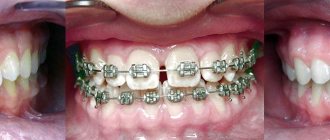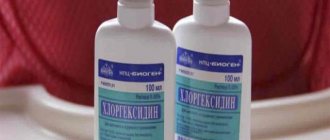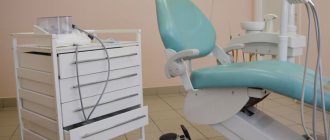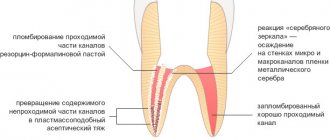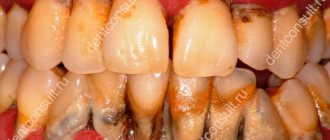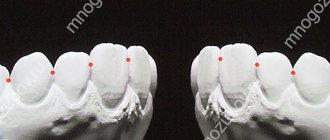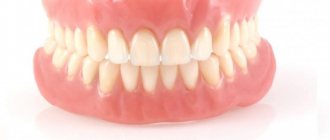4600
In the practice of an orthodontist, the use of a dental mouthguard allows one to eliminate bite problems in children and adults.
They are also used for whitening and for night teeth grinding (bruxism).
The products are removable linings made of silicone or plastic that follow the shape of the dentition.
The accumulation of plaque on the surface of any model requires special and careful care.
The need for daily procedures
Regular and night guards (aligners) require daily care. This is explained by the accumulation of calcium plaque, which increases the growth of pathogenic microflora, causing an unpleasant odor from the mouth.
In addition, a bacterial infection can cause the development of inflammatory processes in the gum tissue (gingivitis, stomatitis). The procedure for hygienic cleaning of the surface of the aligners should be performed in the morning and evening.
When eating, the mouthguard is removed from the mouth. To store it, a special container is used, which must be periodically treated with detergents so that it does not become a “breeding ground” for bacterial pathogens.
It is important to know! The procedure for cleaning the orthodontic structure should be carried out with caution, excluding exposure to high temperatures. You should not use a brush with hard bristles, as it may damage the integrity of the structure of the product material.
Treatment of teeth grinding with mouthguards
Due to bruxism, a disease characterized by involuntary grinding of teeth, a person may experience not only significant wear of the dentition, but also inflammation or deformation of the jaw joint. As a result of using this type of dental guard, muscle imbalance disappears, the jaw relaxes, and headaches, which are one of the unpleasant manifestations of this disease, subside. To achieve positive treatment results, the structure must be worn for about 10 hours a day. In dentistry, there are two types of mouth guards for bruxism:
- daytime - used for daytime bruxism. These are clear, custom-made mouth guards that need to be worn at all times. They are invisible to others and do not cause discomfort.
- night - indicated for night bruxism. Such mouthguards are worn only during night sleep. They are comfortable and do not feel in your mouth.
Stages and methods of cleansing
The dental tray should be cleaned at least once a day, and dental hygiene is best done after each meal. A separate toothbrush should be used.
The daily care procedure is carried out using various means.
Soap solution
To do this, you can use detergent or hand soap with an antibacterial effect. Cleaning the surface of the aligners occurs in stages:
- the brush is moistened with warm water;
- a few drops of detergent are applied to its surface;
- cleansing is performed with smooth movements with a brush;
- At the end of the procedure, the aligner is washed under running water to remove any remaining soap solution.
The material used in the production of the Clearcorrect mouth guard and the timing of bite correction.
Come here to learn more about splint therapy in dentistry.
At this address https://orto-info.ru/sistemyi-vyiravnivaniya-zubov/kappyi-elayneryi/flexiligner-effektivnoe-prisposoblenie.html we will look at the features of the Flexiligner aligners.
Bleach
When using a bleaching agent, you must make sure that you are not allergic to its components. The procedure is carried out wearing protective gloves to avoid damage to the skin.
The procedure is performed following the sequence of actions:
- bleach is mixed with water in a ratio of 1:10;
- the orthodontic structure is placed in a container with solution (for 5-10 minutes);
- The tray is washed with running water until the chemical solution is completely eliminated.
Cleansers for dentures
This cleaning method follows the same sequence as using bleach. The difference is that special tablets purchased at the pharmacy are used to prepare the solution.
Need to know! When using bleach or product cleaner, do not soak for more than 10 minutes. Otherwise, the integrity of the aligner may be compromised.
Sterilization
Due to the fact that dental mouth guards are made of plastic materials, boiling sterilization may damage the configuration of the product. In this case, the structure loses its healing qualities, and the correction of the dentition does not occur in full.
After the first fitting in a dental clinic, sterilization is carried out by autoclaving at low temperatures.
Subsequently (after a week), it is recommended to sterilize the mouthguard using special antiseptics. The Avansept-Active solution is suitable for this.
It is used in the following sequence:
- One part of the antiseptic is poured into a glass or enamel container. Add 5 parts of water to it.
- The aligner is immersed in the resulting composition so that the solution layer above its surface is at least 1 centimeter. The structure stays in it for 10 minutes.
- After removal, the product is washed under running water (5 minutes).
This sterilization method is also used to kill the growth of pathogenic microflora in the mouthguard storage container.
Purpose and essence of using Aqualizer for teeth in dentistry.
In this publication you will find objective reviews of anti-snoring mouth guards.
Here https://orto-info.ru/sistemyi-vyiravnivaniya-zubov/kappyi-elayneryi/byinina.html details about the stages of making Bynin’s mouth guard.
Sterilization of the structure
To avoid complications, the structure must be sterilized. This allows you to destroy infections, pathogenic bacteria, fungi and spores that may be on the surface. For cleaning, a professional autoclave is used in a clinical setting. Self-boiling can deform the structure, so its use is not recommended.
For home care, you should immerse the trays in a special solution for five to ten minutes every week. Rinse the device under water or use antiseptics with water (in a ratio of 1:5) for cleaning. The structure must be stored in a special case.
Terms of use
In orthodontics, the period of wearing a mouthguard depends on the indications for use. So, after the treatment process using braces, dental veneers are used for one and a half to two years to consolidate the effect.
In some cases they are used for life. At different stages of anchorage therapy after braces, the duration of wearing aligners is:
- for the first 2-3 weeks, orthopedic structures are removed only when eating and during hygienic care;
- after 2 months it is allowed to wear it for 2 hours (during the day) and use the structure at night;
- after 4-6 months, it is enough to wear the product 2-3 times a week;
- After a year and a half, the structure is put on once a week.
If the abnormal bite is minor, then mouthguards can be used as an independent type of treatment. In this case, they must be replaced every 4 weeks. In this case, the duration of treatment can range from 8 months to a year.
To correct minor anomalies, clear aligners are used. They are invisible in the oral cavity, and the ability to remove the structure makes it convenient for everyday cleansing of food debris and plaque.
An important point when wearing corrective dental onlays is periodic visits to the orthodontist for their replacement and preventive examination.
In the video, the specialist will supplement the information presented above.
Reviews
In orthodontic practice, experts note the high effectiveness of treatment with mouthguards. The main advantage is the absence of discomfort during correction and simple hygienic care in comparison with brace systems.
You can share your personal experience of using the presented products and ask questions in the “comments” section.
If you find an error, please select a piece of text and press Ctrl+Enter.
Tags mouth guards care
Did you like the article? stay tuned
Previous article
Bite and speech – how closely is the relationship traced?
Next article
Use of dental dams in modern dentistry
Mouthguards for a snow-white smile – safety and effectiveness of the technique
One of the options for giving your smile a flawless whiteness is to whiten your teeth at home using special trays. You do not need to visit a dentist's office to take the course. It is enough to purchase a kit at the pharmacy, and you can carry out whitening sessions yourself. The main thing is to strictly follow the instructions, and also first obtain approval from your doctor. First, a specialist must assess the current condition of the enamel and determine whether this method will be safe specifically in your case. Only after this can you safely start using trays for teeth whitening. Today we’ll talk in detail about this method of brightening a smile, and also give some important recommendations regarding its use.
Composition of the gel inside the aligners
Thermoplastic and standard models usually come complete with a universal gel, the main active ingredient of which is hydrogen peroxide or carbamide peroxide - we already talked about this a little higher. Additionally, components are added to the product that help reduce hyperesthesia after the procedure - we are talking about sodium and fluoride.
But when choosing individual overlays, the composition of the lightening gel will be selected individually, depending on the degree of darkening of the enamel and its current condition. In this case, the concentration of the active substance may be slightly higher. So, for example, in professional products its indicator can reach 45%, while for home whitening methods gels with a concentration of no higher than 15% are used.
Restrictions while wearing aligners
There are still some restrictions when wearing aligners.
Orthodontists strongly advise against chewing gum while wearing aligners, as it can stick to the surface of the aligners and cause the aligners to become deformed.
It is also recommended to limit smoking while wearing a aligner, as this may not have the best effect on the appearance of the aligners.
How to use correctly - instructions for use
To do everything correctly, achieve the desired result at home and not harm your teeth, it is important to follow all the instructions in the instructions. Experts also suggest taking note of the following recommendations:
- before installing the product, you need to thoroughly brush your teeth, rinse your mouth and blot the enamel with a dry paper towel,
- then we take out the pad and fill its inner surface with gel - the dosage is indicated in the instructions,
- We fix the mouthguard on the jaw so that it fits tightly to the row on both sides. It is important that it does not come into contact with the mucous membrane. If you bought a thermoplastic set, you need to wet the product with hot water before use,
- if you squeeze out more gel than you should, just gently remove the excess with a paper towel,
- At the end of the session, you need to rinse your mouth thoroughly with water.
The photo shows filling the mouthguard with whitening gel.
You can leave the mouthguard overnight only if this is permitted and specified in the instructions. If during bleaching you experience unpleasant or even painful sensations, the procedure should be stopped immediately. It is worth taking a break and be sure to consult a doctor.
